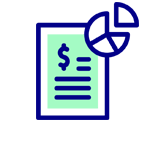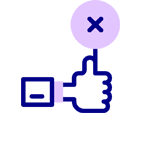CRM for distribution industry and wholesale relies on a variety of methods and procedures to manage complex businesses. Among the business processes are the relationships with customers, suppliers, and manufacturers. In order to remain competitive and outperform their competitors, they must increase sales and productivity. A shorter sales cycle, lower costs, and better customer service are ways to achieve this.
Similarly to manufacturers, distributors focus on their supply chain to gather relationship and transactional data. As opposed to downstream suppliers, upstream suppliers for manufacturers are primarily OEMs and raw material suppliers. Due to their roles as middlemen in the selling process, distributors' typical upstream supplier is the manufacturer. A CRM solution for distribution companies can help cultivate both types of partner relationships. CRM software for distribution industry and wholesale relies on a variety of methods and procedures to manage complex businesses.

Payments and Distribution
CRM integration with a payment gateway expedites payment processing and reduces paperwork. You won't have to sift through stacks of paper documents to find what you're looking for. CRM software for the distribution industry keeps track of both customers and items in one place. CRM monitoring and reporting tools can assist distributors in managing customer data, tracking product orders, generating invoices/quotes, and automating marketing efforts. CRM's Distribution and payment module assists industries in a number of ways.
- Redirect a payment request to your customer via the CRM, where all of your other documents are stored and receive funds instantly.
- To significantly reduce the risk of fraud, encrypt data transfers.
- Ask your customer to pay you directly through CRM rather than taking credit card numbers over the phone or requesting a cheque.
- Integrated payment solutions vastly improve the customer experience and assist you in maintaining your relationship over time.
- For immediate payment, use the cloud-based invoice process.
- Integrating your payment processing tools with your CRM gives you a better understanding of your business, not just financially, but also marketing-wise.
- Payments should be consolidated in order to determine which marketing channel produces the highest ROI.
- Assists sales representatives in generating new leads and maintaining existing relationships.
- Representatives keep track of sales activities, take notes from customers, and promote internal collaboration.
- Sales increased and customer service improved as a result of the activities.
- Assume control of the management and customer service processes.
- Maintain business operations while building strong customer relationships.
- Streamline the movement of goods across the supply chain.
- Marketing and sales management tools, as well as automation of intensive customer-centric processes, are available.
- Data in real time assists the sales team in converting leads into customers.
- Marketing and sales management tools, as well as automation of intensive customer-centric processes, are available.
- To convert leads into buyers, get real-time data.

Marketing and Sales
In order to boost revenue, reduce the sales cycle, increase conversion rates, and improve forecast accuracy, teamwork is necessary between the sales and marketing department. With Sales enablement, businesses can improve buyer experiences, align their marketing and sales teams, and empower their representatives to be more productive and efficient by using sales enablement CRM software for distribution. Sales enablement is becoming increasingly popular among sales and marketing executives.
- Deeper insight into prospect profiles, as well as robust analytics, are provided to identify quality leads.
- Gather a wealth of customer data — purchase history, behavior patterns, and preferences — and figure out what they need.
- Make personalized offers to customers that are highly relevant to their needs.
- Increase sales and revenue by offering efficient services that increase customer satisfaction.
- Routine tasks and processes should be automated, and mundane processes eliminated.
- Reduce the possibility of human error by providing accurate information at all times.
- Get a variety of opportunities to build a loyal customer base.
- collect customer information as well as information about each interaction, allowing for a better understanding of client needs and ensuring personalized service
- Concurrent marketing campaigns were launched across multiple sales channel touchpoints, including regular mail, email, mobile, social media, and the web, among others.
- Evaluate your customers' online activity to determine what matters most to them and to derive business value from this information.
- Route the brand/product mentions as well as reply promptly to assess the effectiveness of social media campaigns, and so on.
- Monitor and manage the company's social media presence in an efficient and time-efficient manner.
- Data storage and processing allow marketers in customer segmentation much more precisely, depending on factors ranging from geographic location to financial information, previous interactions, and so on.

Functions and Workflow automation
Distribution CRM operations and workflow automation require the maturation of business processes. Automation may exacerbate the problem if business processes are inefficient or wasteful. Before attempting to automate a business's processes, it should first ensure that they are optimised. On the other hand, automation of mature and optimised processes can help organisations gain a competitive advantage in terms of speed and cost.
- Automate tasks to reduce the chance of human error.
- You can create a more satisfying work environment for your employees by automating mundane tasks.
- Seek out talented individuals rather than hiring labor.
- Your labor costs will decrease.
- The integration of various departments within the organization allows tasks to be completed more efficiently.
- Real-time data can help you improve your sales and marketing effectiveness.
- Grow your business without adding new systems or employees.
- Organize your information and focus on the things that matter most.
- You can easily align multiple marketing campaigns while managing large amounts of data.
- Conduct a thorough analysis of the data, identify potential leads, and follow up right away.
- Optimize the customer service process to increase efficiency.

Expense and transactions reporting
The tracking of business expenses is a major concern for all businesses, and that is made difficult by paper receipts, handwritten notes, and manual processes. Companies can use software to track and monitor employee spending to improve expense management, eliminate errors, and expedite reimbursements.
Expense management is responsible for tracking employee spending and determining how the organisation will reimburse the costs incurred. It also employs the procedures and policies that are used to manage this type of spending.
- By automatically routing expense reports to approvers and paying approved expenses electronically, you can save time and money on processing.
- Recover out-of-pocket employee expenses much faster than in the past, increasing employee satisfaction.
- Duplicate entry detection software can detect duplicate entries, reduce the likelihood of data entry errors, and prevent overpayment.
- Lower processing time and cost boosts operational efficiency and frees up employees to focus on higher-value tasks.
- Automated expense management software uses custom rules to flag out-of-policy expenses.
- Dashboards display metrics such as employee expenses and expenses by category, as well as the time required to approve expense reports.
- Employees can use their smartphones to scan receipts and submit expense reports from anywhere. Managers' and their replacements' manual tasks have been eliminated.
- Real-time visibility into employee, project, and category expenses is provided by reporting and analytics.
- Compliance is made easier by software, which automatically categorizes expenses and creates an audit trail for tax purposes.

Quote and Invoice
The quote and billing maintenance module of CRM software for the distribution industry assists various divisions within the company in identifying new leads and strategizing for distribution forecasting, thereby accelerating the sales process. CRM quote management tools that use simple invoice and quotation generation tools aid in the streamlining of the sales proposal process. Our Distribution CRM solution can also be tailored to your specific needs and integrated with other accounting applications if you have them.
- Build custom invoices for various accounts.
- Create an invoice and send it manually, or schedule it to be delivered at a predetermined time during your billing cycle.
- You can now monitor the status of your payments (pending, received, scheduled).
- If a payment is late, you will be notified immediately, and you can send follow-up emails directly from your dashboard.
- With automated billing, quotes can be obtained more quickly.
- To generate automated invoices and bids for each customer, use variable pricing.
- The built-in rate contracting programme calculates the correct contract price for each customer using various rate cards and pricing charts.
- You can generate precise quotes in seconds by using built-in rate cuts and discount limits.
- Reduce inventory management overhead by calculating and providing a total price for each order.
- It is possible to control and use a comprehensive billing software system.
- Obtain a comprehensive report that contains information about your outstanding payments, approved payments, received payments, and prepared quotations.
- Keep track of late payments and missed billing periods by running regular reports.

Complaints and feedbacks
Managing, responding to, and reporting customer complaints is a difficult task. To ensure faster resolutions, the complaint management process must be streamlined and constantly monitored. Every business requires an online complaint system with multichannel capabilities, advanced reporting capabilities, a platform for cross-functional collaboration, and an instant customer feedback system.
- Allow your customers to provide feedback via their preferred platform.
- In a consolidated CRM database, you can easily manage and organise all of your customer information.
- To increase customer engagement, keep a record of your clients and prospects through multiple customer touchpoints such as social media, email, website, blog, and so on.
- You can assist your company in responding to consumer complaints as quickly as possible by effectively monitoring them.
- Make a positive first impression, inculcate trust in your company, and eliminate any negative thoughts.
- Enhance the effectiveness of the customer relationship management process.
- All of your client-related data is kept in one place by a central repository system.
- Bring all of your prospects and current clients together in one place.

Employee and customer tracking
CRM software for the distribution industry can collect and consolidate lead data at every point of contact thanks to the tracking feature. CRM enables the distribution industry to collect more data, track it more precisely, and identify the most effective customer engagement channels. Activity tracking, by mapping the patterns of behaviour that lead to a purchase, can help sales teams move more proactively, recognising when a lead is ready to convert early on.
CRM can also track the activities of employees, salespeople, and dealers to ensure that the right product is delivered to the right customer at the right time and in the right condition.
- Create effective strategies for gaining valuable insights and driving ROI by utilising analytics tools.
- Leads can be easily tracked to see if they are worth your time and money.
- To convert leads into prospects, improve your follow-up strategies.
- Leads classified according to their preferences.
- You will be able to save money if you use the information you have gathered.
- Rate the leads according to their quality.
- Better interactions with prospects result from nurturing.
- Before approaching a random lead, provide your representatives with information about the lead journey.
- Keep an eye on how your employees and salespeople conduct themselves.
- Follow the path of the product.
- Help ensure that the products arrive in the best possible condition.
Order and Purchase management
Orders and Purchases CRM The management process improves customer service while also increasing sales efficiency and productivity. To meet customer contact strategies, CRM projects must integrate existing operational processes and organise back-office procedures. To achieve maximum integration between a CRM solution's framework and an organization's existing back-end processes, Lighthouse's distribution CRM software combines an integrated view of processes and organisations.
- Evaluate orders placed and get order details in real time..
- Keep an eye on inventory levels.
- Clients are categorized based on the quality, quantity, and size of their orders.
- Get instant access to inventory and stock information.
- Automation can help to reduce maintenance and inspection costs.
- Purchase telematics and status updates in real time improve service delivery and customer satisfaction.
- Optimize back-office functions to improve service delivery.
- You can improve information sharing and reporting across all departments by integrating all systems with an expanded cloud platform.
- Decrease the load in order to contribute to the organization's long-term viability.
Campaign Management
CRM allows you to collect and organise customer data, as well as identify customer preferences. It also includes all of the information needed to educate customers and prospects about your products or services. Campaign management and planning ensure that the right information is delivered in the right format, at the right time, and to the right clients. Because it revolves around the needs of the customers, campaign management is an important component of Customer Relationship Management (CRM). CRM software is used by the distribution industry to manage their internet marketing initiatives.
- CRM manages and tracks advertising campaigns.
- Marketing campaigns and phases can be created and generated automatically for a variety of client categories.
- PPC, Google Adwords, and traditional marketing campaigns, as well as email marketing campaigns, should be planned alongside other types of campaigns.
- Marketing methods should be mixed and matched.
- Use online forms to collect information from your contacts and assign them follow-up tasks.
- You can create extensive listings to filter your contacts for different campaigns and sub-campaigns by segmenting your database.
- Create automated marketing campaigns to stay in touch with your contacts on a regular basis.
- Lead monitoring and campaign assignment can both be done through your Sales CRM.
- Track your ROI by keeping track of your client open rate, click-throughs, and engagement.

Questions? We're here to help.
Our advisors are here to help you chart a course to success. They can answer all your Lighthouse CRM-related questions, including topics like:
- Our entire product portfolio
- Pricing information
- Implementation and adoption planning
Just fill out the form at left or call
+91 -
86006 66106.